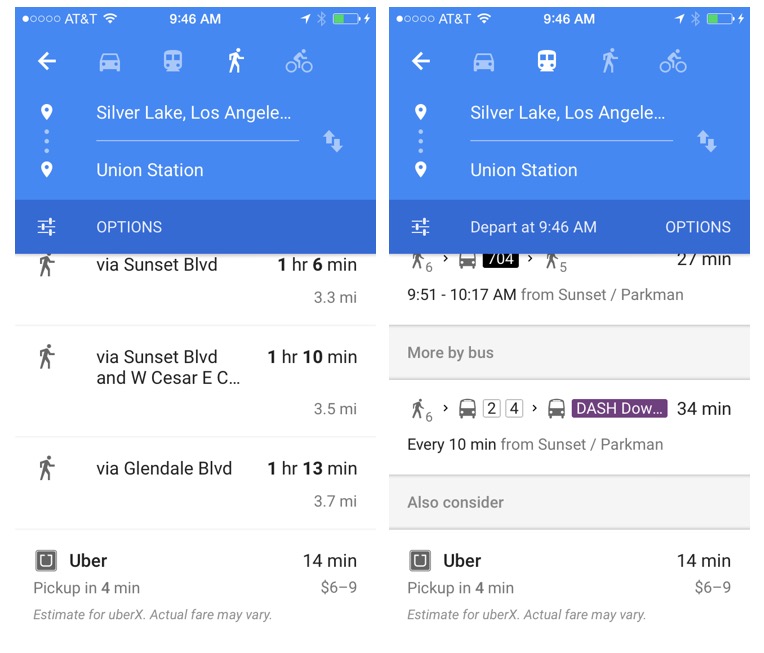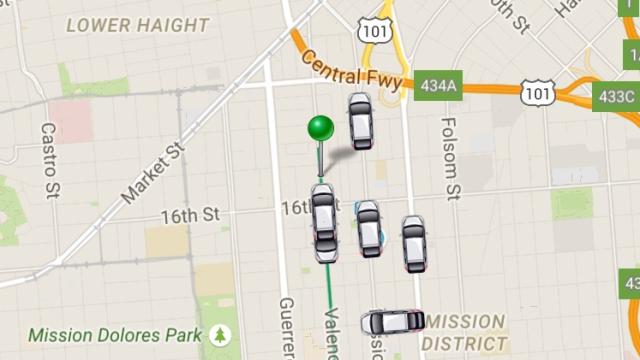I’m writing this from a train. Without access to a car, I had to make a plan this morning for how to get to an interview: rent a car, ride a bike, take a train and a bus, use an on-demand ride service. I chose the train for a few reasons. But mostly because I believe that choosing public transportation is the best way — the only way — to make it better.
Good transportation is all about choices. This is what I thought about as I flipped through the Google Maps app on my phone this morning, weighing my options. When I punch in an address, four different modes — drive, public transport, walk, bike — are splayed across the top of my screen. I can deliberate based on time, cost, route, distance. Technology helps me make my decision for how I want to get around my city that day.
I am lucky to have a choice. Most public transport riders don’t. But I also see the decisions I make to take public transport as part of my civic duty: My ridership is making that train service, that bus service, that bike share service better for the people who don’t have choices.
That’s why Uber makes me feel so conflicted. Not only because of some well-publicised smarmy practices (which actually caused me to delete the Uber app — I only use Lyft and Curb now), but also because Uber is very clearly trying to replace public transport as a way to get around, as many smart stories have mentioned this week.
It was about a year ago, after Google invested heavily in the startup, that the Uber option started popping up on Google Maps. “ALSO CONSIDER” it says at the bottom of the directions for walking or taking public transport, taunting me with promises of an air-conditioned Prius vs a sweaty 10-minute wait at a unshaded bus stop.

At first I was enraged that what’s basically a native ad would encroach upon my transportation decision-making. But then I started to look at the rates. Often, Uber is more convenient and cheaper. A Metro Los Angeles day pass is $US7. See how much that Uber fare is?
Because of the precipitous drop in prices thanks to uberX or the ridesharing services like UberPool (or LyftLine, or what have you), there are people — lots of people — who now use Uber to commute great distances to work EVERY DAY. Like this woman from San Francisco who decided not to buy a car and go “full Uber” for one year. She estimates she gave $US4600 to Uber to fulfil her transportation needs during a 12-month period, which she compares to spending over $US10,000 a year on car payments, parking, gas, insurance, etc. In certain cities, using something like Uber is a better deal than owning a car. But it’s taking those people off public transport.
This week, Uber made its most transit-eqsue move yet, launching a program called Smart Routes that directs riders to more heavily trafficked streets for pickup. I could almost see passengers walking the extra block to a busy corner, waiting for their private car just feet from a bus stop. Over at The Awl, Matt Buchanan imagines a near-future where this kind of Ubering becomes so ubiquitous that it morphs into its own network of private-public transport (or public-private transport?) that slowly replaces, or maybe even merges with, our existing buses and trains.
This is already happening. Tampa’s system is launching partnerships with Uber and Lyft to get riders from stations to their homes, essentially solving the first mile-last mile problem that steers a lot of potential riders away from public transport. But think about that for a moment: Tampa wants people to ride its buses so badly that it is enlisting Uber to help get people to its bus stops. When Uber’s rates go down even more as the service saturates the region, what’s to stop them from riding that air-conditioned Prius all the way to work? Enough passengers do that and bus service is cut.
Buchanan points out this fear in his piece: That Uber’s success will lead to what’s essentially privatised mass transport. That’s not really a concern in a place like New York City where ridership is very healthy and the subways are the best way to get to many places. But when you look at any smaller American city that’s trying its darnedest to get a new public transport system off the ground, ridership numbers make a difference. If elective riders — the people who have a choice — aren’t boarding, that transport system is going to fail.
The taxi industry might be making the loudest complaints against Uber, but it’s the struggling public transport system in Tampa that’s really in trouble.
There’s one more twist. Uber’s push for self-driving tech is happening. Soon, among the uberX and UberPool options you might see a UberAutonomous button, summoning a self-driving vehicle to your doorstep. This cheapest option — cheapest because there’s no labour — would be a slightly larger vehicle, almost like a van. The driverless technology would plot an efficient route using real-time traffic alerts but also choose the most economic path to your destination by scooping up other Uber customers along the way.
Sounds a heck of a lot like transport to me. But it’s not public. It’s not accessible, it’s not equitable, and it’s not serving the entire city. I refuse to believe that a fleet of robot cars operated by a single company is ever going to be a better transportation investment than a bunch of really fast fucking trains, smarter buses, solar-powered gondolas, and a comprehensive bike share that also includes e-bikes, kayaks, scooters, and maybe a few of those hoverboard-y things.
I want more options, not less, when it comes to getting around my city. And that’s why I’m taking the bus.
Read the whole story at The Awl.
